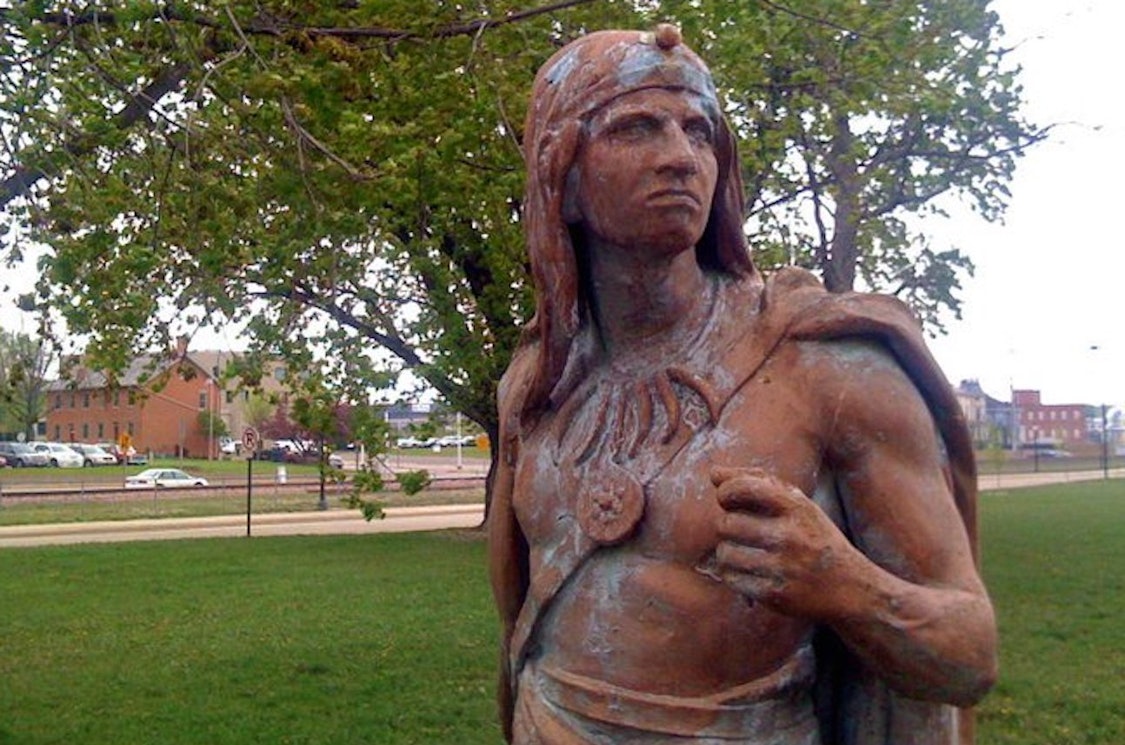
Statue on Muscatine’s Mississippi riverfront erected in 1926 by the all-white Improved Order of Red Men.
This column by Daniel G. Clark about Alexander Clark (1826-1891) first appeared in the Muscatine Journal on June 7, 2023, under the headline “Alexander Clark does RAGBRAI?”
What would Alexander Clark say about Muscatine gearing up for another horde of RAGBRAI visitors in their sweat-drenched thousands?
A stretch of the imagination to wonder such a thing? It’s what I do while researching 19th century newspapers for dots connecting local Black history to—everything.
Clark was more than Equal Rights Champion. He did much to make his hometown better. Movers and shakers patronized his Hair Dressing Saloon, so he knew what was happening. He enjoyed travel, and his marketing sense and public demeanor took him places, especially in later years.
RAGBRAI? As many parades and pageants and fundraisers as he organized or addressed, I say he’d be on the committee. He’d capitalize on the opportunity to enhance his brand (freedom, equality, justice, active citizenship) and perform his oratory if asked. The chamber of commerce would court his support early, and the mayor would introduce him as orator for the day.
What about his take on a fast-tracked gift of the World’s Biggest Watermelon? We know about young “Aleck’s” prize-winning squash at the 1857 fair, so I think he’d be all for giving away melon and holding biggest-melon contests and promoting our local produce as best anywhere. Apparently he later owned a farm where melons were likely raised, maybe inside today’s Kent/GPC property.
I bet he’d be all in favor of Mayor Brad Bark’s Melon, but I also imagine him warning against choosing a design, however well intended, that might play into mockery of the “colored” residents.
From Watermelons, Nooses, and Straight Razors by David Pilgrim, curator of the Jim Crow Museum, Ferris State University, Michigan: “The problem is not that African Americans are shown eating watermelons on thousands, if not millions, of material objects. Rather the problem is that blacks are portrayed as contented coons, Toms, mammies, and pickaninnies, with all their hopes, dreams, and fears sated by eating watermelons.”
Of course Muscatine would not condone racism or contribute to ugly ridicule, not intentionally anyway. But having seen the Confederate battle flag on our streets, even at the tail end of a parade not so long ago, I am a little wary and won’t feel entirely shocked when that first Muscatine Pickanniny meme goes viral.
“Picaninnies had bulging eyes, unkempt hair, red lips, and wide mouths into which they stuffed huge slices of watermelon.” (Jim Crow Museum)
But that wasn’t here, you say? Not here in Iowa where we ended racial segregation right after the Civil War. Yup, it was. This very newspaper published that very word on “the latest list of unusually hard words prepared for the benefit of spelling matches.” (May 7, 1875)
Historian James Loewen, author of Lies Across America: What Our Historic Sites Get Wrong wrote for the History News Network website:
If we go straight up the Mississippi River to Iowa, eventually we will reach this statue in Muscatine’s Riverside Park. A half-clad male Native American gazes toward the Mississippi. It says ‘Presented to the city by the Musquitine Tribe #95, Improved Order of Red Men’ and ‘dedicated to the Mascoutin Indians in 1926.’ Not only did Native Americans have nothing to do with the statue, but for more than half a century after its dedication they were not allowed to join the society set up to honor them! When the statue went up, there were two Red Men for every Native American, and it looked like American Indians were a vanishing race. Today the Red Men are down to just 28,000, while Native Americans total more than two million. Now, however, Native Americans can join the Red Men, although the organization does not know if any have ever done so.
Mayor Bark’s Melon, however, got more advance scrutiny than the Improved Red Men’s gift. Their statue was the first of many decorative installations promised from various clubs and associations for the city’s brand new Riverside Park. It was a rush job for hosting the society’s state gathering here. In fact, the dedication got pushed back in the program when the bronze man didn’t arrive on time.
Muscatine Journal, October 12, 1926: “G.A. Allbee, local attorney, made the presentation to the city on behalf of the Red Men. Charles P. Hanley, member of the levee commission which created the park, accepted the gift. I.B. Richman gave a historical sketch of Indian life in this territory. Robert T. Crowe, great Incohonee of the United States and chief guest of honor during the convention, gave a dedicatory address.”
How does our venerable aborigine hold up today? Why, he wears a life vest for every major flood!
Black History and Red Men and public art on the Riverfront.
Seriously, though, Juneteenth comes before my next column, so please observe our national holiday and take its meaning to heart. When I return, I’ll take at least one more stab at the melon and memories of RAGBRAI past.
Next time: Watermelons along the Great White Way
